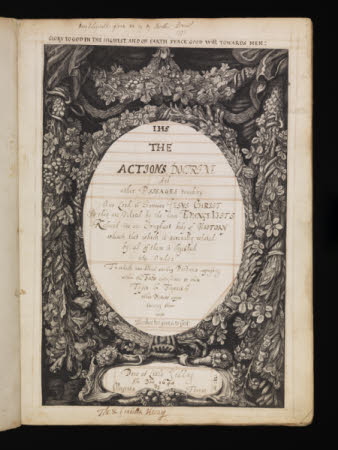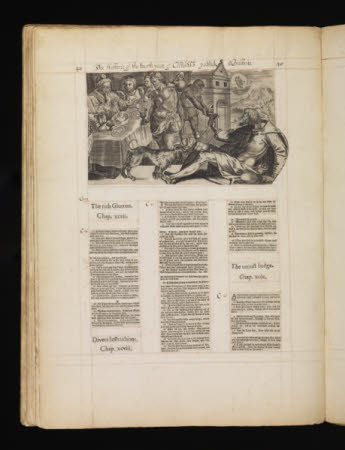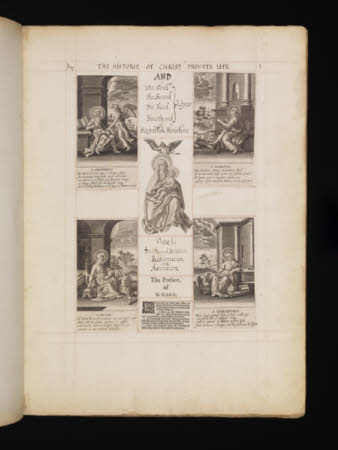The actions, doctrine and other passages touching our Lord and Saviour Jesus Christ . as they are related by the foure Evangelists reduced into one compleat body of history wherein that which is severally related by all of them is digested into order. To which are added sundry pictures expressing either the facts themselues or their types & figures w[i]th other matters appertaining thereunto. Done at Little Gidding A[n]no Dom. 1640 by Virginia Ferrar an: 12:.
Virginia Ferrar (1627-1688)
Category
Manuscripts and documents
Date
1640
Materials
Paper, Vellum
Place of origin
Little Gidding
Order this imageCollection
Ickworth, Suffolk
NT 3092921
Caption
A small religious community in 17th-century Cambridgeshire produced some of the most unusual illustrated religious books of the period. Created between 1625 and 1642, these innovative scrapbooks were beautifully constructed from Continental prints and texts from the New Testament focusing on the life of Christ. The community was founded at the manor of Little Gidding in Huntingdonshire by Nicholas Ferrar (1593–1637) and his mother, Mary (1553/4–1634). The creation of the books was largely the role of the women of the family. The meticulous techniques of cutting and pasting, disguising paper joins by using heavy pressure, created a new type of product and an inventive approach to book composition. This even led some to speculate that they had invented a form of printing. The volume shown here was made by the 12-year-old Virginia Ferrar (1627?–88), with handwritten additions by her father, John (1588?–1657). The community of Little Gidding was the inspiration for a poem of the same name by the poet T.S. Eliot (1888–1965) in 1942.
Summary
Full description
The Christian community at Little Gidding was established in 1625 by Nicholas Ferrar (1593-1637) and his mother, Mary (1553-1634), and followed a rigorous routine of prayer and scripture reading. Nicholas directed the community in the creation of gospel harmonies by cutting and pasting passages from printed English New Testaments to create a unified account of the life of Christ, supplemented by images cut from continental religious prints. No other contemporary devotional publications were illustrated to such a degree. The cutting, composition and pasting was undertaken by the women of the community, with a keen eye for detail and design. The intricacies of the arrangement and the heavy presses used to secure the compositions rendered the joins of the images invisible, leading some to think that the community had invented a new form of printing. The harmony now in the collections at Ickworth - one of eight surviving volumes - was composed by Nicholas’s twelve-year-old niece Virginia Ferrar, with handwritten elements by her father, John. A particularly elaborate harmony, now in the British Library, was made for Charles I, who was a great admirer of the Little Gidding books and visited the community twice. It is likely that this royal endorsement persuaded the Ickworth volume’s first owner, Thomas Jermyn - possibly Sir Thomas Jermyn (1573-1645) - to acquire it. (Tim Pye 2019 & Nicola Thwaite 2021)
Bibliographic description
[x], 66 p. . ill.. . fol... Provenance: manuscript inscription: Arthur J Hervey [i.e. Lord Arthur Hervey, later Bishop of Bath and Wells (1808-1894)] Given to him by his Father [i.e. Frederick William Hervey, 5th Earl & 1st Marquess of Bristol (1769-1859)] 1845 Ickworth. Another: Mary Fitzgerald [i.e. Mary Fitzgerald (1726-1815)] given me by my Brother Bristol [i.e. Augustus John Hervey, 3rd Earl of Bristol (1724-1779)] 1793. Another: Tho: & Isabella Hervey [i.e. Sir Thomas Hervey (1625-1694) and his wife Isabella (1625-1686)] Large armorial bookplate: The Right Honble. John Lord Hervey Created Baron of Ickworth ... 1702. [i.e. John Hervey, later 1st Earl of Bristol (1665-1751)]. At end: Thomas iermine [presumably a relative of Susan Jermyn (d. 1637), first wife of Sir William Hervey (1585 or 6-1660)] [...] this Book. Another inscription by the same on front fly leaf. Three letters and a note on mourning paper, dated May-June 1899, to Frederick William John Hervey, 3rd Marquess of Bristol (1834-1907) from his aunt Patience Hervey, widow of Arthur (d. 1904) presenting this book and giving an account of its history.. Binding: Tooled parchment binding; (fleurs-de-lys and heart stamps arranged as small centre and corner-pieces); the tools much worn but formerly gilt; pink silk ties renewed by Birdsall of Northampton; a sample of the original silk is inserted in the Ickworth copy of Acland-Troyte with a note by A. Birdsall; marbled pastedowns.
Provenance
Part of the Bristol Collection. The house and contents were acquired through the National Land Fund and transferred to the National Trust in 1956
Makers and roles
Virginia Ferrar (1627-1688), creator John Ferrar (1590-1657), writer Nicholas Ferrar (1592-1637), creator
References
Barker, Nicolas. Treasures from the libraries of National Trust country houses. 1999., no 49 Ransome 2005: Joyce Ransom, ‘Monotessaron: the harmonies of Little Gidding’, The Seventeenth Century (2005)


